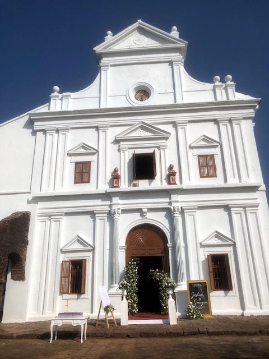For THE GOAN
The Chapel dedicated to Our Lady of the Mount, Nossa Senhora do Monto or Santa Maria do Monte is located on a small hillock, called Monte Santo, overlooking the Mandovi River on the east of Old Goa.
 It is one of the oldest chapels in Old Goa. From here, one gets a beautiful scenic view of the Mandovi River, Old Goa itself and the Island of Divar. There are a fleet of steps and a road to have access to it. Mass is celebrated here on the 8th of each month. The Feast will be celebrated this year on September 7, though the feast is on September 8, with the High Mass at 10 am.
It is one of the oldest chapels in Old Goa. From here, one gets a beautiful scenic view of the Mandovi River, Old Goa itself and the Island of Divar. There are a fleet of steps and a road to have access to it. Mass is celebrated here on the 8th of each month. The Feast will be celebrated this year on September 7, though the feast is on September 8, with the High Mass at 10 am.
THE HISTORY
The chapel has a very interesting history behind it. The Portuguese historians frequently mention that the hill was the bullwork of the Mohamadans as they had placed their heavy pieces of artillery here, which caused havoc among the forces of Alfonso de Albuquerque, the Portuguese Governor to Goa, who was sent to conquer Goa.
He based his artillery on the hill of Our Lady of the Rosary Church and launched his first attack in March 1510 on Adil Shah of Bijapur to take possession of Goa, which however failed. Then he launched his second attack on November 25 the same year and this time he succeeded.
Alfonso de Albuquerque realised the importance of this spot and sometime after the victory, it is stated that in fulfilment of his vow, he ordered a chapel to be constructed there. The same was completed in 1519. There is an inscription in Portuguese on a marble plaque on the façade wall, placed there in 1931, which reads thus, ‘Aqvi postou-se a artilharia Maometana contra Afonso de Albuquerque para retomar Goa em maio de 1510’ (Here the Mohammedan artillery stood against Alfonso de Albuquerque to retake Goa in May 1510).
THE DEVELOPMENTS
Down the years, the chapel was reconstructed once or twice. Many additions have been made to the chapel, like the two-storey loggia attached to the northern wall of the church. Against the north-eastern wall and the eastern façade, some extensions were also built which are behind the altar.
The chapel had outhouses or a residence where earlier the chaplain from the Cathedral, who was in charge resided there, and looked after the parishioners.
Due to its secluded location, it was in ruins till 2001. Fundação Oriente, an organisation that maintains cultural links between Goa and Portugal, in association with the State government and the Archdiocese of Goa restored the chapel, giving it a new look; the front porch was removed and the whole façade was opened, keeping only one at the left side. The main altar was also fully restored.
THE CHAPEL
The length of the chapel is 33 metres; its breadth 14 metres and the thickness of the walls is 2.7 metres. Its roof is covered with Mangalore tiles. The material used for the structure is laterite stone and the architectural style is that of Baroque with Mannerist influences.
The three storeyed façade of the Chapel resembles that of the Sè Cathedral. The main door is simple with a half curve and at the side there are two columns, the top flanked by two windows.
The walls have three sections; the ground floor section has entrances with windows crowned with triangular pediments on the upper section. This is surmounted by a central panel flanked by wings which hide the gable roof of the chapel. It had a pulpit which was stolen in the 1980s. There are several memorial slabs in the dusty floor of the chapel, the one in front of the main altar is that of Antonio Alvares Pereira, the architect of the chapel.
THE ALTARS
The chapel has three altars. The middle altar has the statue of Our Lady of the Mount, holding the Child Jesus. Above it is a picture of the coronation of the Blessed Virgin Mary and below that a picture of Our Lady of Assumption. The side altars were dedicated to St. Anthony of Lisboa and to St Anthony.